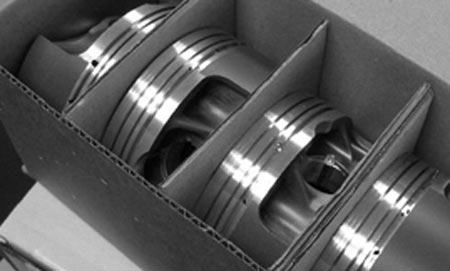Piston skirt coatings
If you attend a motorsport trade show and look at the pistons on offer, you will see that a number of them have a coating (or sometimes more than one coating). More often than not, where a single coating is applied to a piston, it will be a skirt coating. Piston skirt coatings are very commonly used, and the practice is not just a recent phenomenon.
There are a number of reasons for the use of a coating on a piston skirt. The conclusion many people will jump to is that they are primarily to reduce friction, but this isn't always the case.
One important reason to use a skirt coating is to protect the piston during 'running-in'. During the initial period of engine running, either using a new piston or in a completely new engine, there is an excess of friction compared to normal running, owing to asperity contact. A low-friction or lubricious coating can help in this initial period. The coating doesn't have to be especially durable, and coatings based on phosphates, graphite and resin-bound polymers have all been used for this purpose.
Where the piston design will be used by a range of drivers of differing abilities, and cars with varying cooling efficiency and duty cycles, the ideal piston skirt profile can be difficult to produce. With a coating of substantial thickness, the piston can develop its own profile to a certain extent, as the piston coating 'wears in' to a shape based on they way the engine is used and driven. This practice has been used to quickly develop skirt profiles, and is documented in SAE Paper 820769*. The process described in the paper is one where the engine is run for a while under real operating conditions, and the 'worn-in' skirt profile is then copied to a real piston. Where coated pistons are run continuously with the aim of wearing in to an ideal shape, the underlying piston skirt profile should be reasonably close to the end result.

Of course, one area of interest to all engineers concerned with producing competition engines is that of friction reduction. Whether your competition is NASCAR Sprint Cup, Formula One or Shell Mileage Marathon, you want as little as possible of the chemical energy contained in the fuel to be wasted in frictional losses. Some of the coatings applied for improving run-in or skirt-profile compliance will have an effect on friction, but there are also piston coatings that are applied specifically to reduce friction.
A number of companies now have DLC-coated pistons commercially available for racing customers. As mentioned in the Race Engine Technology articles on pistons (RET 43, November 2009 and RET 61, March/April 2012), the adoption of DLC is far from simple. Not only is the coating very specialised owing to application temperature and other parameters, the machining of the piston also markedly differs from a conventional, non-coated item. If you try to apply any old DLC to your pistons, you will probably get a very different result from that desired!
With the desire to produce ever-more reliable and increasingly efficient engines, piston producers and users will continue to turn to coatings to help them achieve their goals.
Fig. 1 - Piston skirt coatings are specified for a number of reasons
* Yagi, T., and Yamagata, I., "Experimental Method of Determining Piston Profile by Use of Composite Materials," SAE Technical Paper 820769
Written by Wayne Ward